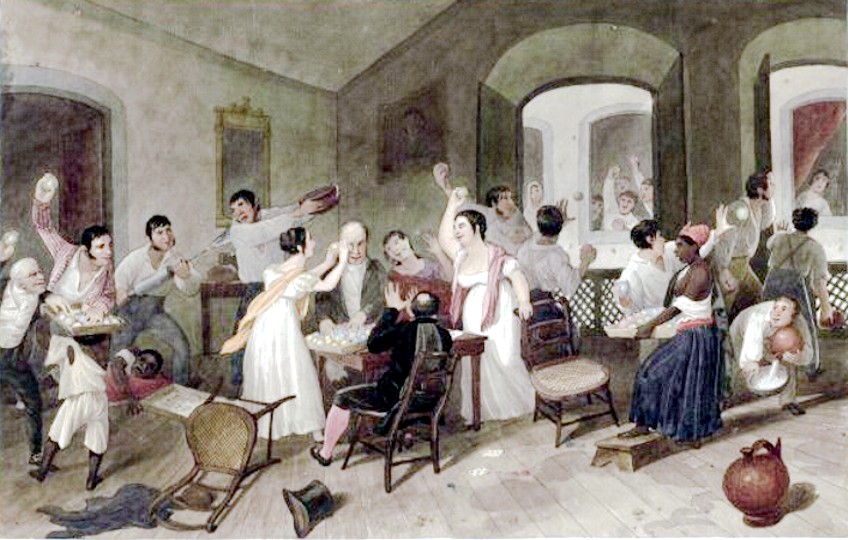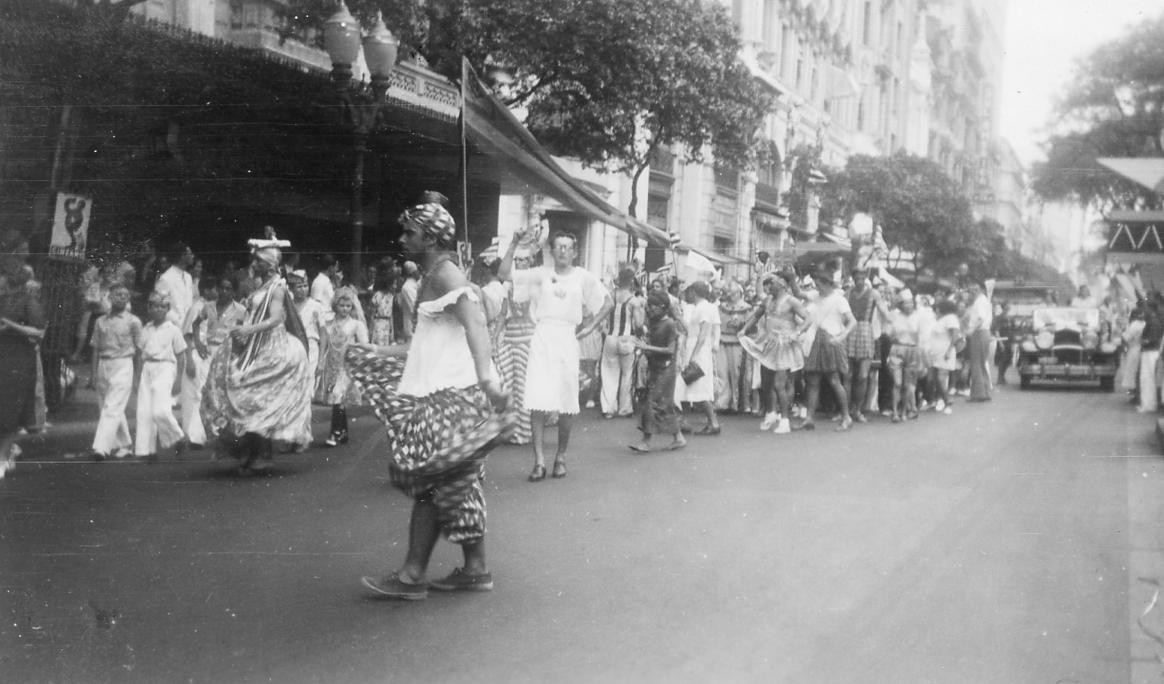Your neighbors make you a scandal for having a party with 20 decently dressed people.
In the meantime, somewhere in the world there is a party that lasts four days, gathers millions of people, the life and souls of the party are almost naked, and yet no one bangs on the pipe, nor the door. What is it? The Grand Carnival in Rio de Janeiro – this party is held annually.
What happens to those neighbours who want to sleep? In this case, they leave the city. (Really!)
On this page:
To Whom and How Came the Idea of a Colossal Party?
It seems that Brazilians were born partygoers, because shortly after their emergence as people, the Brazilian carnival also appeared.
“The ancestor” of this festival was Entrudo, a Portuguese festival that was held just before Easter Lent. It marks Shrove Tuesday by tradition. At that time, there was no question of samba, costumes, and lavish parades. Back then, people celebrated by throwing water and mud on one another – a kind of “let’s fool around now seeing as during Lent we cannot.” Can you imagine just how fun it is to see your relatives and neighbours soaked, muddy, and with a smile? Luckily this happens in the summer, in the heat of the sun! Because yes, it is summer in the southern hemisphere during this time of year.
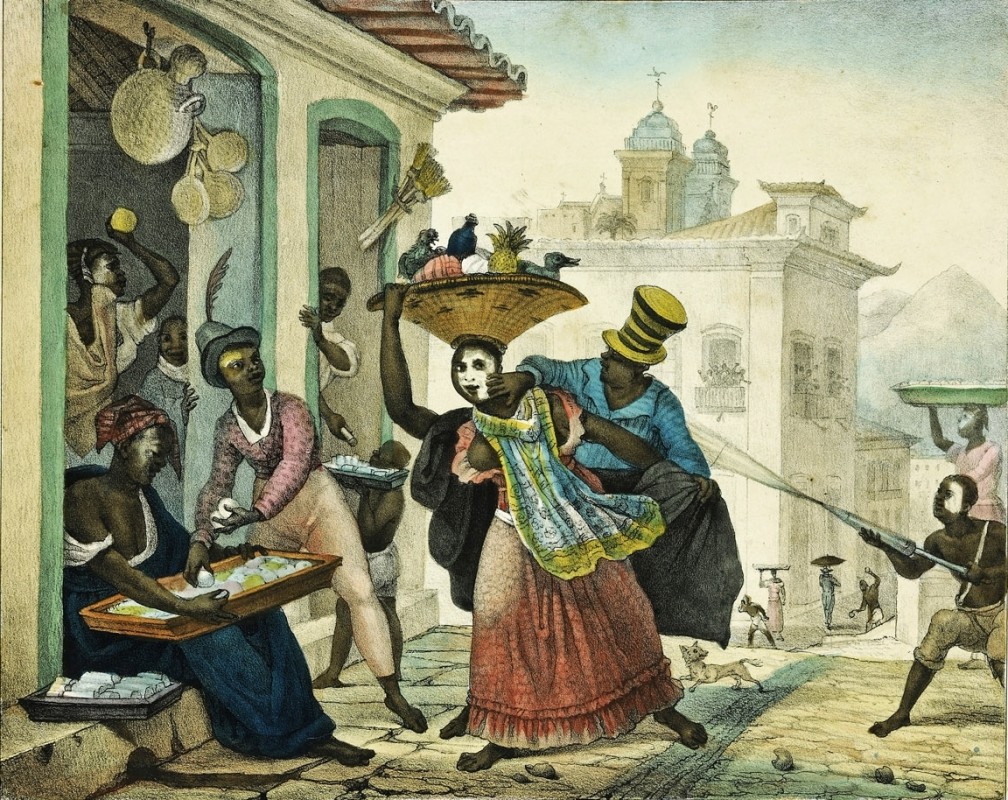
By the 1600s, the Portuguese immigrants brought this tradition to the colonies, without having any idea what turn things would take. The feast gathered momentum in many places in Brazil, accumulating over the years. But nowhere has reached the staggering rates as the Carnival in Rio de Janeiro. The first mention of the Carnival dates back to 1723 1)”113 Festivals to Attend Before You Die” by Herbert Howard, book published in 2015 – and even if then it wasn’t a big deal, now it is famous worldwide!
In 1840 the first well organized celebration appeared 2)”The Prehistory of Samba: Carnival Dancing in Rio de Janeiro, 1840-1917” by John Charles Chasteen, study published in the Journal of Latin American Studies in February 1996. Perhaps they grew tired of so much rout, so the mud fights were replaced with a masked ball, where they danced the polka and the waltz, as it was done in Europe.
The current version of the Carnival received an initial boost from a shoemaker with a mood for ad-hoc shows, named José Nogueira de Azevedo. Shortly after the appearance of balls, he had the idea to make parades with family and friends, also involving others along the way 3)”Carnival (Holidays and Celebrations) ” by Daniel Shafto, book published by Chelsea House Pub in 2009.
It seems that the idea was very well received, because in 1855 “gentlefolks” also started to participate in the parades. But since they did not mingled with the “rabble”, they came in sumptuous floats and were wearing fancy costumes 4)”Rio de Janeiro: Urban Life Through the Eyes of the City” by Beatriz Jaguaribe, book published by Routledge in 2014. This swagger was quickly turned into a competition. Thus appeared Grandes Sociedades (The Great Societies) – clubs that purpose was to create the coolest parades! As you can see in football competitions, Brazilians show so much passion and excitement. You realize that everyone partakes in this kind of enjoyment. All the high society participated in parades, which were headed by the King.
Between 1870 and 1950, carnival masks and costumes were very popular. Each participant tried to be above each other. It was a travesty if something else was too expensive.
I wonder how you will disguise yourself?!
Carnival on Samba Rhythms
What was missing for the event to become the carnival we know today? Samba! The festive dance appeared in 1917. Where does the name Samba come from? It is uncertain, but there is a theory that says that the name comes from an African language, spoken in Nigeria.
In 1928 “samba schools” appeared. The first samba school established was Deixa Falar 5)”Almanaque do samba: a história do samba, o que ouvir, o que ler, onde curtir” by André Diniz, book published in 20066)”CultureShock! Brazil: A Survival Guide to Customs and Etiquette” by Volker Poelzl, book published by Graphic Arts Center Publishing Company in 2006, shortly followed by Mangueira – later considered to be one of the most famous schools. And if the term “school” makes you think of learning, do not worry! Here you will only learn how to have fun, Brazilian style. Samba schools are clubs that have space for a group of people to dance samba. They are rather similar to sports associations. So if you were thinking you’re into sport, here’s an idea: Samba!
In the beginning, for more than 30 years, this dance was considered to belong to the people of the lower classes. Only in the 60s and 70s, with the Cultural Revolution and the hippy movement, samba became popular among the middle class and rich people.
Also beautiful women (and others) expose their increasingly appetizing curves. Each samba school puts their most attractive representative in the front. Her role is Rainha de Bateria (Queen of percussionists) and she is right in the front of “the army” that keeps the pace. There is also the Carnival’s Queen, selected a few months before by contest to take the job. And there are a few other queens and princesses, because monarchy is not what it was. However, all good-looking Brazilian women (plus several Brazilian men) dream of becoming a queen, at least a little one, at the Grand Carnival.
Be honest: you could not wait to get to this part! When you hear of Rio Carnival, it’s one of the first things you think about – beautiful women dancing the samba!
What Lies behind the Costumes of the Dancers?
Every year there are dancers with ornaments so big that it seems they are butterflies and prepare to fly. At least in the case of young women, outfits sometimes seem mere thread knotted in a few places.
In fact, the costumes hide a very laborious work. It takes thousands of hours of work by hundreds of people each year in order to create them. The part manufactured from common materials can be sewn on the machine and takes relatively little time. The fun comes when all those beads, feathers, and sequins must be applied by hand right where the designer said. Sounds exciting, right? Now think about that while you work carefully, as the head coordinator breathes on your neck. Then, after you’ve given your soul to finish the job on time, someone appears to look at your work with a suspicious mother-in-law’s eye. That person being the quality inspector.
I wonder what people wore to carnivals in the past? Those of Portuguese’s time wore everyday clothes, only water-soaked and soiled with mud. In the period of the first parades, since the Grandes Sociedades, clothing consisted solely of the most elegant hats and clothes that a man had at home, without any change in them. Then came the period of classic carnival costumes, especially travesty.
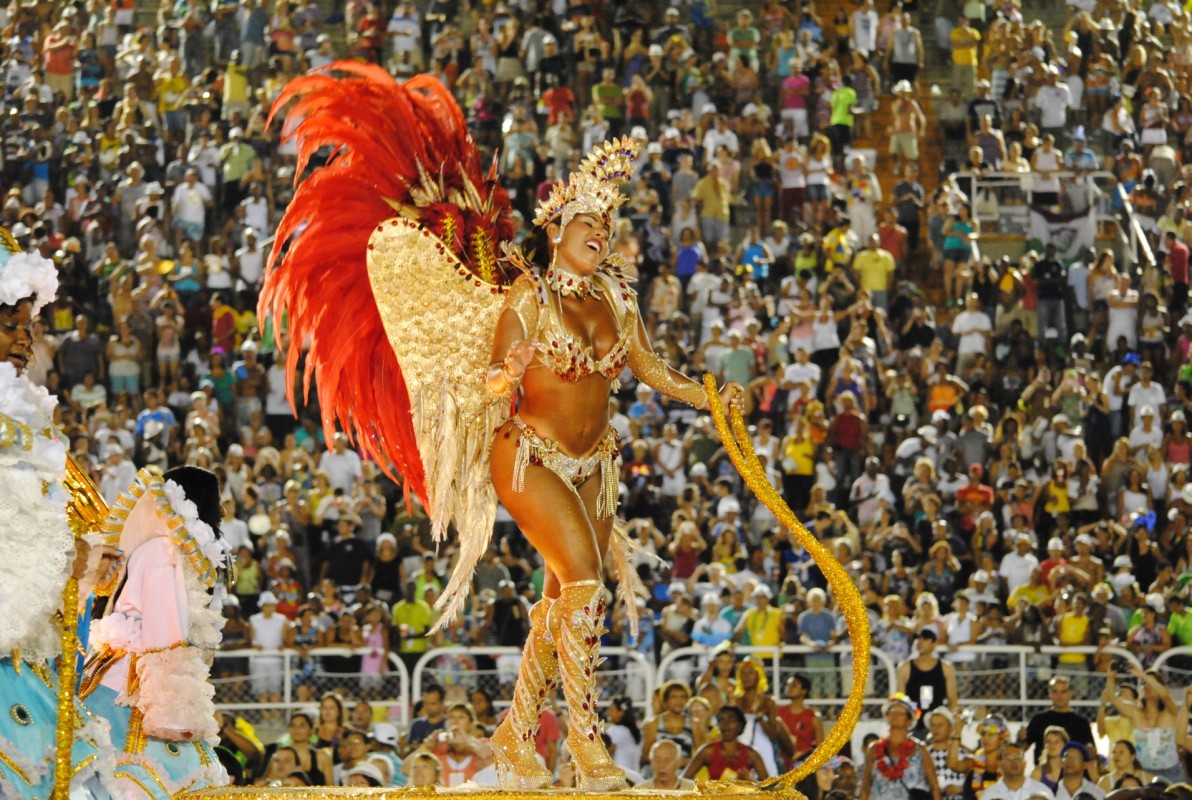
Currently, some of the dancers outfits are so tiny that sometimes you wonder why they wear them. There are several reasons why the costumes appear to have shrunk:
- the suffocating heat of February in Brazil
- when dancing for hours, you get very warm
- freedom of movement and highlighting the steps of samba
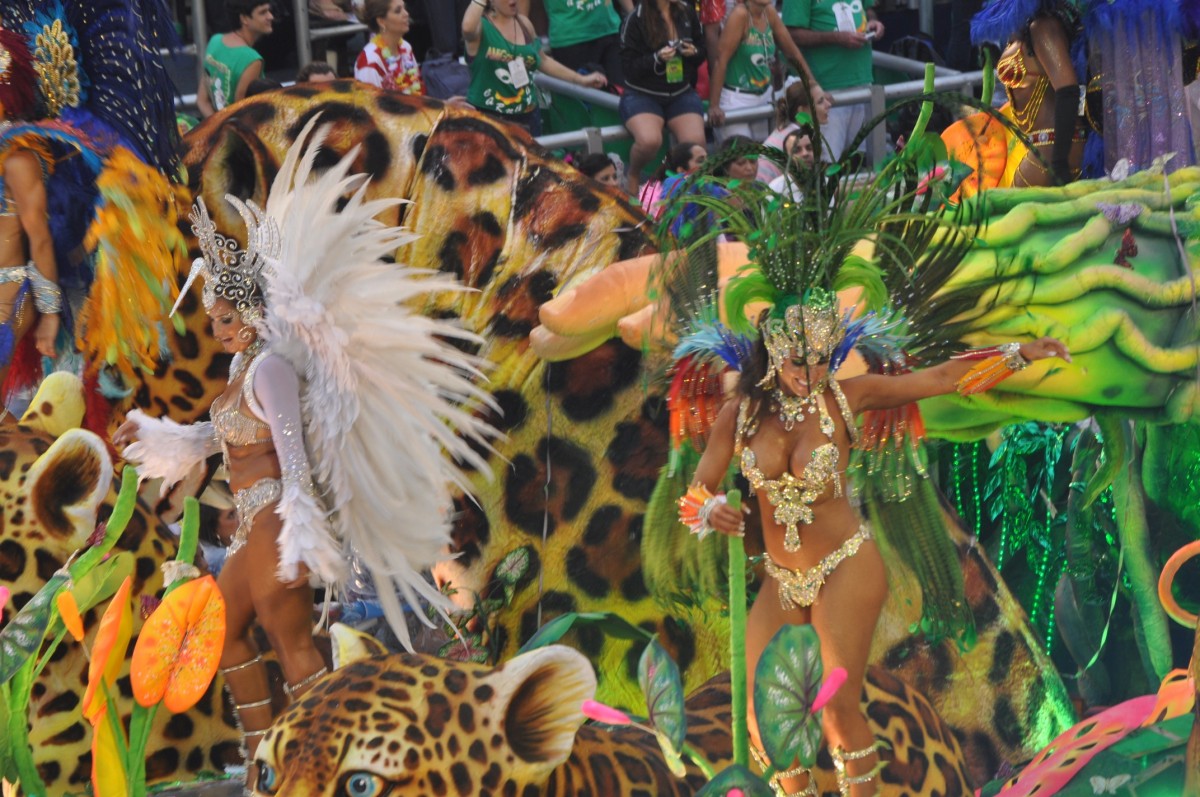
How come no one protested against a so scantily clad parade? To the delight of the current and former participants, reduction of carnival clothes did not encounter any objections from others, Brazilian society is known for its libertinism.
Not all costumes are scarce today. In fact, most of those who are part of the parade are ordinary people who just march, without much dance. They are dressed thematically, elegant, proudly supporting a certain school of samba. It does not have to be sexy for that. The important thing is to want to enjoy life. Everyone is welcomed!
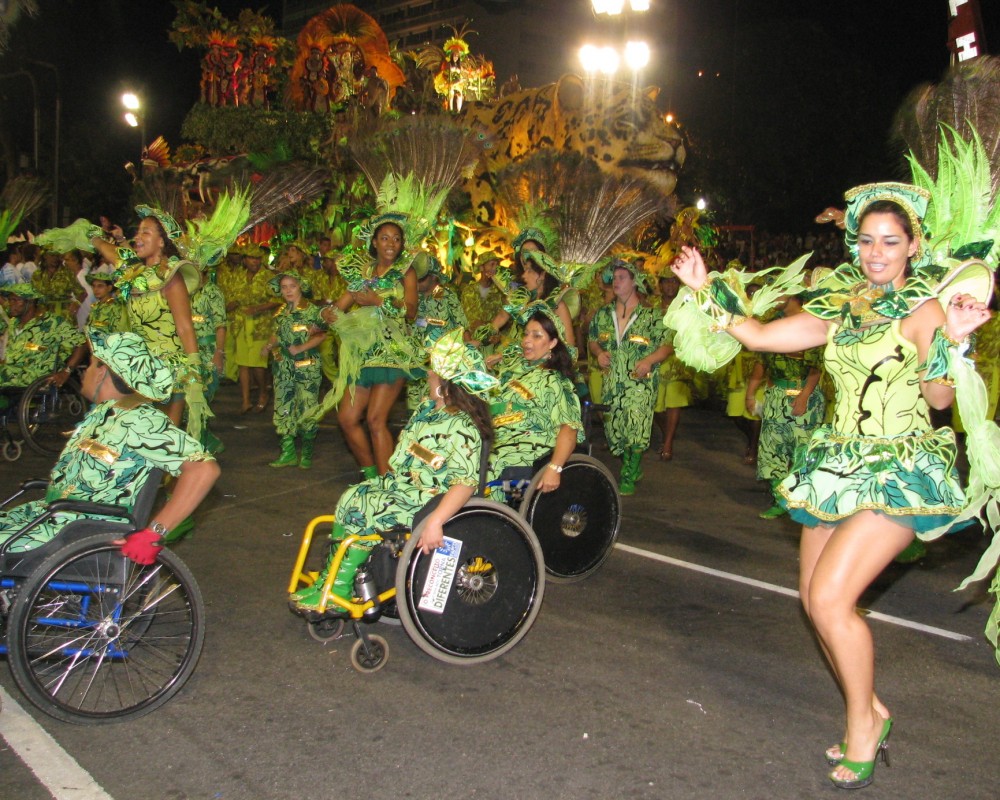
Unfolding of Forces
Festival in Rio de Janeiro is a crazy party that lasts four days. Every year it begins on Saturday and it ends on Tuesday because Wednesday Easter Lent begins. The same to you: every year, from Saturday to Tuesday, you wonder how no one stops the revelers in Rio.
On the other hand, put yourself in the place of the ordinary Brazilian. To dance and drink for four days becomes terribly boring. So a party of this scale is divided into events. Of all, the most important is the Sambadrome parade. The main schools of samba take part in the parade, in a fierce competition. Each school chooses one theme and a storyline, trying to impress as much as possible.

Obviously, Carnival in Rio is not (at least not anymore) a celebration of religious inspiration. But Christian symbols often appear in the parade: Mary, participants dressed as nuns and cardinals, etc. At a very short distance from sensual bodies and exciting dances. All watched over by the imposing statue of Christ on the Corcovada mountain top.
After all, this mixture of sacred and profane is only the world concentrated in a few minutes.

Sambadrome Marquês de Sapucaí (as it is officially called) is big as a boulevard. It was built in 1984 and has an impressive length of 700 meters 7)”Sambadrome Marquês de Sapucaí” in Wikipedia. The stands can accommodate 90,000 spectators – and you can hardly find a place, even the cheapest costs about as much as minimum wage.
If you are on a low budget, you can stand on the stairs, as those in football stadiums. Different areas have different prices. There is also the option for a higher cost, you can have your own balcony from which to watch the parade comfortably.

Do you have any idea how long the preparation takes?! They begin many months in advance. For many locals, it is the most exciting activity throughout the year.
In the metropolis there are almost 200 schools of samba. All would like to attend the Sambadrome, but it would be impossible. They are divided into value groups (like the one in the divisions in team sports). Carnival is the most important competition, involving only Group A and the Special Group.
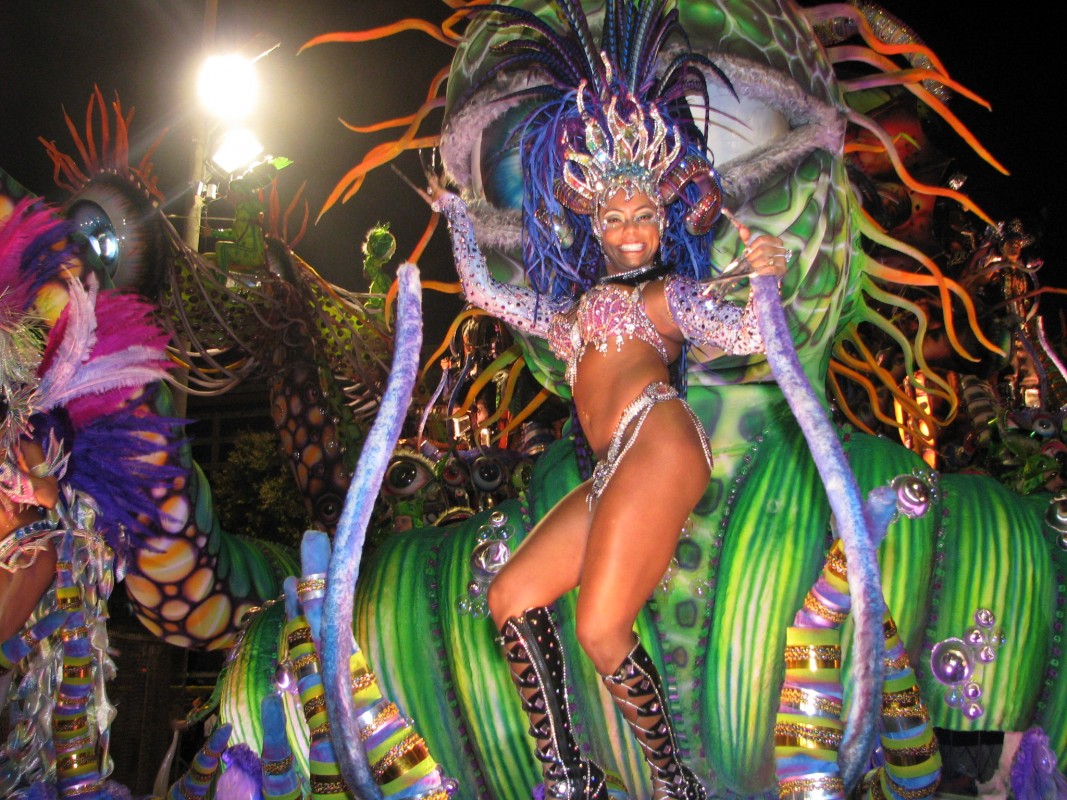
The selection criteria is related to music, dance, costumes, and theme of each school. It is a great honor to dance at the Brazilian Festival, so incredible that a lot of money is spent for costumes, floats, and other preparations. However, most people that dance are poor, the bottom layer of society, who are brought by the thousands and dressed up by each samba school to make the most impressive unfolding of forces.
Once you know the cost, you will probably have a better understanding of why you must buy a ticket to enter the Sambadrome and why it is so expensive.
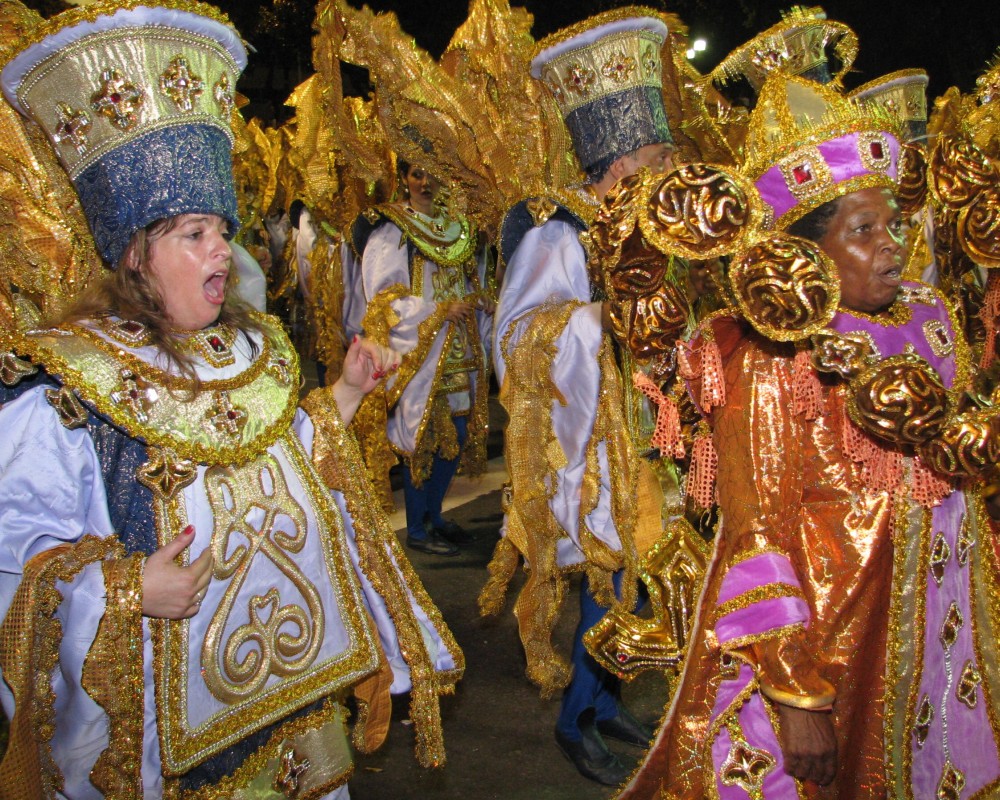
You know what’s cooler than watching the parade from the stands? Being a part of the parade! Yes, if you want to really feel the carnival, you can contact a participating school of samba in advance. And you will be accepted. But unlike their people, you will have to pay for your costume. A piece of cake: somewhere between 150 and 400 euros. It would be ideal to learn some lyrics, but at this price, no one minds if you only move your lips like a fish.
The starting ritual at the carnival will amuse you terribly. The Mayor hands a huge key, made of gold and silver, to the King Momo. This fat king, a symbol of wealth, gives the start of the party.
As a tourist, you see a stunning show. But for locals, the competition is just as important. The panel of judges calculate their scores… That kind of passion you find only on the Maracanã Stadium, also from Rio!
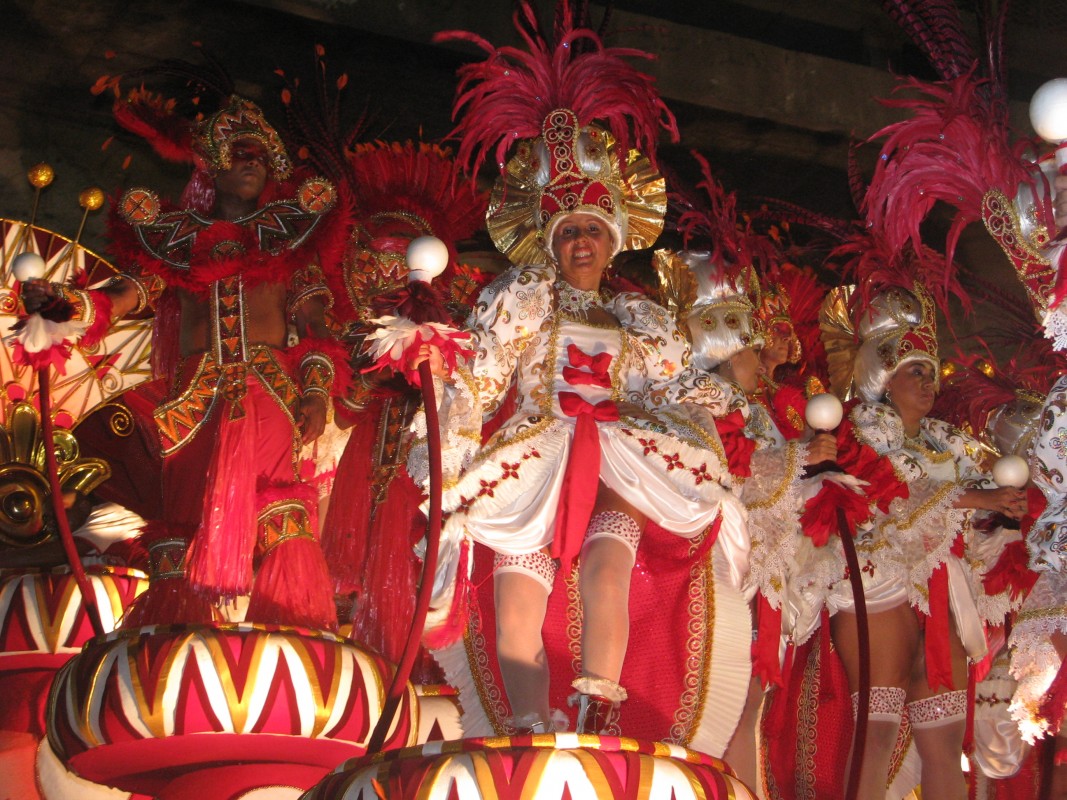
All the Sambadrome parade takes about 10 hours. Every… night. (Yes, it’s like a wedding party.) Six samba schools have one hour and a half to impress the spectators. If the math is throwing you for a loop, don’t forget to calculate for the breaks in between.
The last day is the gala: the top 5 ranked in the Special Group, but also the one ranked first in Group A, once again present their show on the Sambadrome. To remain in your memory at least until the next time!
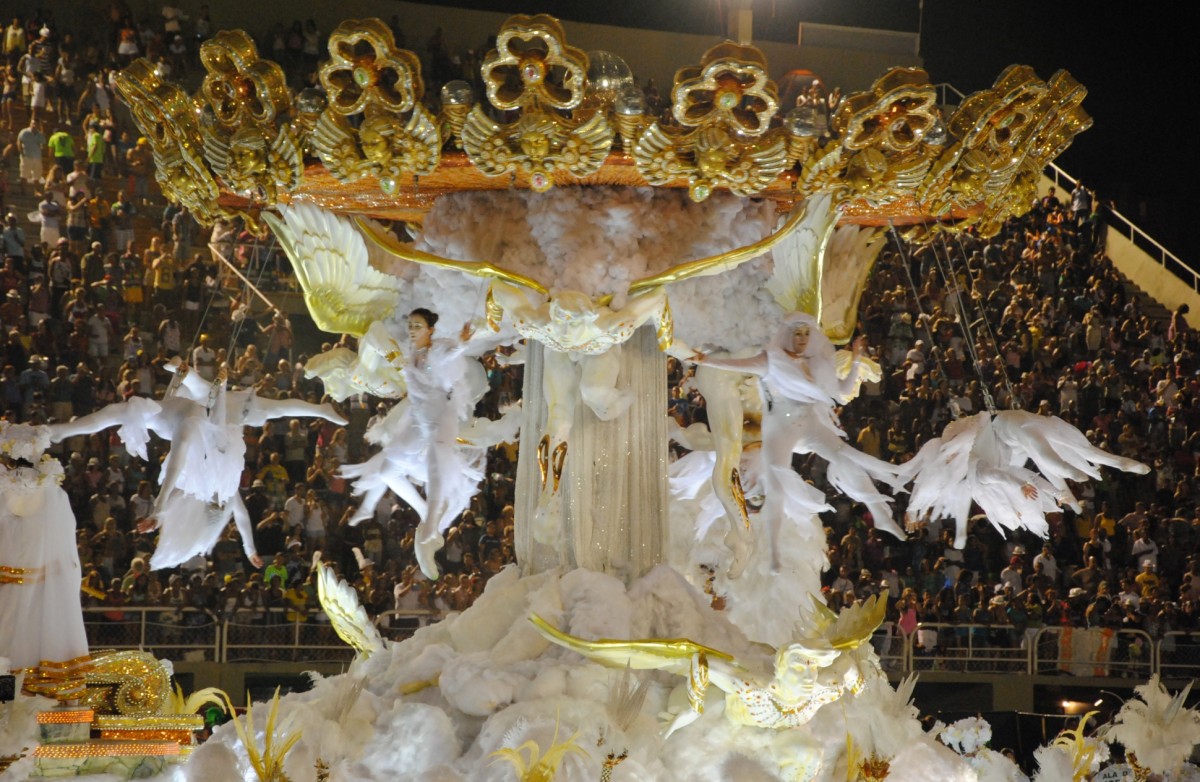
The Surprises Waiting for Tourists
You are so jolly that your friends sent you to the carnival in Rio, and they still do not believe you will be satiated with parties? They might be wrong and you will get some surprises.
If the great “battle” between samba schools does not give you much satisfaction, you can try the famous blocos, parties that take place on the streets. They are more family-friendly, because its participants are more covered with costumes. The nice part is that you can count yourself among them, especially if you have a carnival costume. You do not even have to bring it from home, you can rent it there.

How do you find parties in the street? It should not be too hard. All you have to do is walk around the city and you are sure to find a few parties. For example, in 2012 there were 425 such street parties. Most have a reasonable participation, but can reach huge dimensions, with millions of revelers in one place 8)”Rio’s 2012 Carnival in Numbers: Daily” by Sarah de Sainte Croix, article published in The Rio Times on February 28, 2012. You cannot even imagine that!
In fact, it’s hard not to find a blocos. To take a nap in peace. Because no matter how much you like the party, at some point you fall victim to fatigue. It is understandable, even some local people, when the Carnival comes, are leaving the city in all horizons.

Rio is a great city of fun. It seems that even the founders were absent-minded. In 1502, on New Year’s Eve, Portuguese explorers arrived in Guanabara Bay. They thought that the gulf was a large river estuary. Being January 1, they called the place “Rio de Janeiro”, which means “River of January” in Portuguese. But there’s no trace of the river. Perhaps the explorers, who should have checked to see if the river existed, preferred to sunbathe. Can you blame them?!
But here it was a premonitory mistake: now rivers of people flow through these places.
Rio Carnival in Numbers
Rising crime rates in Brazil are well known. Even so, the Carnival in Rio manages to annually collect half a million of brave foreigners, twice as many Brazilian tourists, who join the millions of residents participating in the great feast. Who would miss such fun?!
Incomes from carnival are amazing. In 2012, revenues were estimated at 1.45 billion reais (about 850 million US dollars) 9)”Rio’s 2012 Carnival in Numbers: Daily” by Sarah de Sainte Croix, article published in The Rio Times on February 28, 2012. And the trend for these values is to grow: in 2014 the estimates were close to 1 billion dollars!
For Rio de Janeiro, these figures mean about 250 thousand jobs. The disappearance of the festival would be an economic disaster.
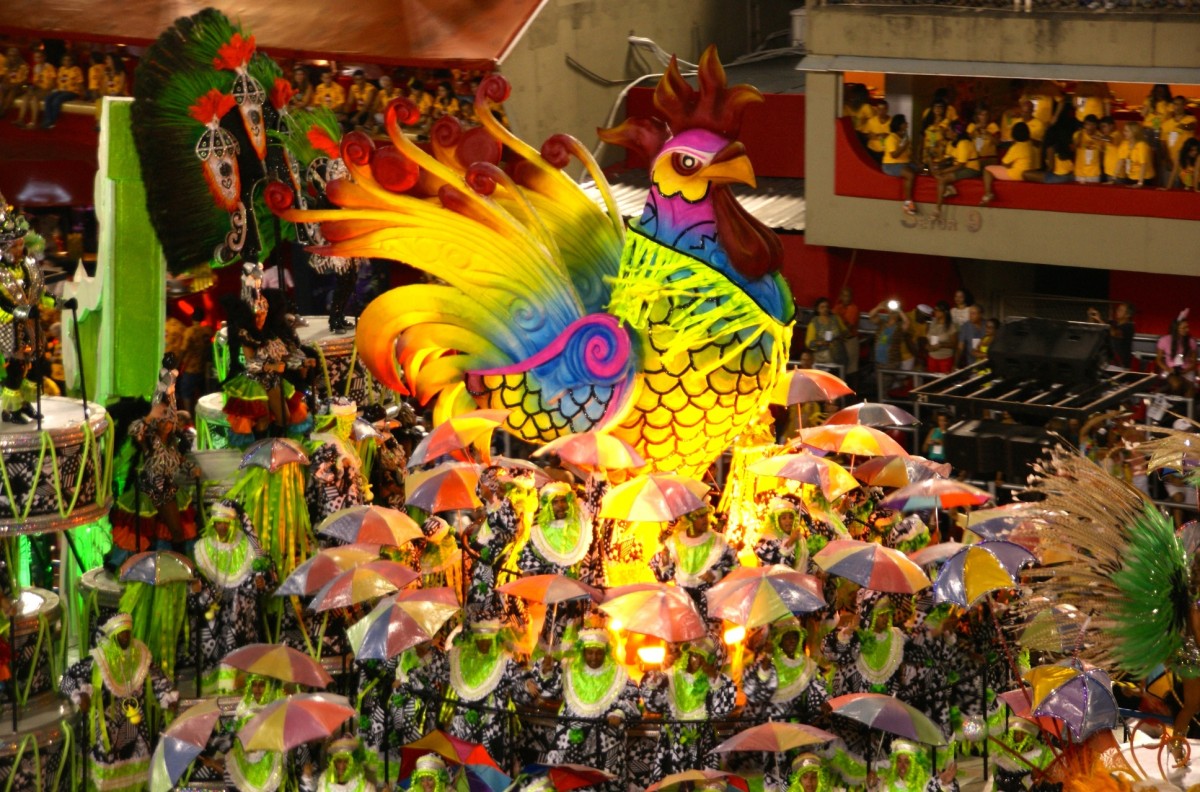
On the other hand, the amount of money invested is also quite high. Each samba school has a budget of several million dollars. When you put them together, it gathers about 50 million dollars. And that’s just for the show on the Sambadrome!
You know what is left behind when your 20 party guests leave your house party. Can you imagine what remains behind after several million people had fun for four days? Cleaning is a costly pain.
However, when the line is drawn, Carnival in Rio is a highly profitable business.
Do you remember what I said at the beginning? This madness is a way to mark Shrove Tuesday. And I was thought that if I had a good meal, I went wild!
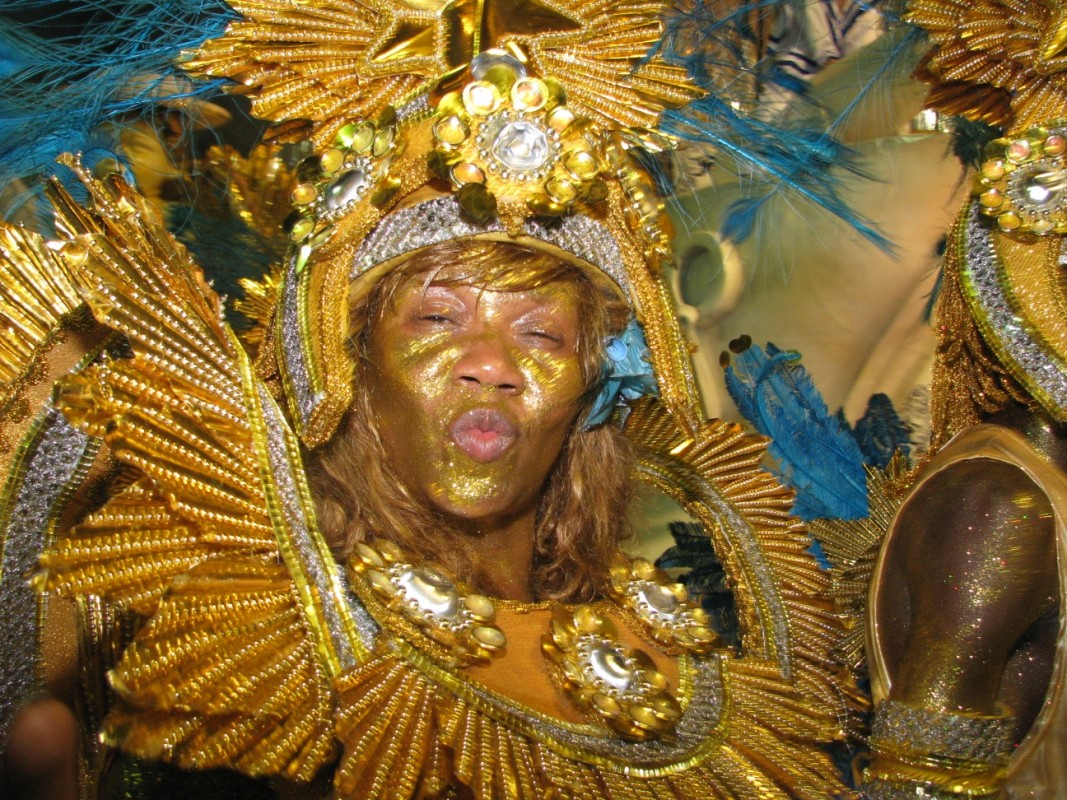
The most spectacular information about Switzerland presented in a fun way, but well documented, with matching illustrations
References
| ↑1 | ”113 Festivals to Attend Before You Die” by Herbert Howard, book published in 2015 |
|---|---|
| ↑2 | ”The Prehistory of Samba: Carnival Dancing in Rio de Janeiro, 1840-1917” by John Charles Chasteen, study published in the Journal of Latin American Studies in February 1996 |
| ↑3 | ”Carnival (Holidays and Celebrations) ” by Daniel Shafto, book published by Chelsea House Pub in 2009 |
| ↑4 | ”Rio de Janeiro: Urban Life Through the Eyes of the City” by Beatriz Jaguaribe, book published by Routledge in 2014 |
| ↑5 | ”Almanaque do samba: a história do samba, o que ouvir, o que ler, onde curtir” by André Diniz, book published in 2006 |
| ↑6 | ”CultureShock! Brazil: A Survival Guide to Customs and Etiquette” by Volker Poelzl, book published by Graphic Arts Center Publishing Company in 2006 |
| ↑7 | ”Sambadrome Marquês de Sapucaí” in Wikipedia |
| ↑8, ↑9 | ”Rio’s 2012 Carnival in Numbers: Daily” by Sarah de Sainte Croix, article published in The Rio Times on February 28, 2012 |
Did you like it? Now it’s your turn. You’ll make us very happy if you share this article with your friends:
And don’t forget to let us know what you think – we are really interested in your thoughts on this!



